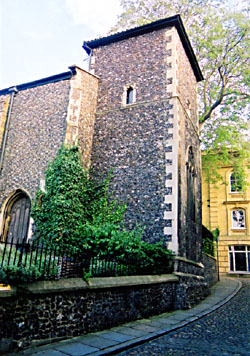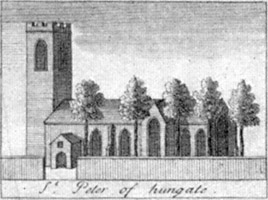
St. Peter Hungate,
west end viewed from Elm Hill
Photo © S. Alsford
Built in 1254, the church served one of the smaller but populous parishes in the core of Norwich, lying between castle and riverside, with the Dominican friary on its west side. There were half a dozen other churches within a radius of 120 yards, reflecting population growth and parochial subdivision. The current structure was finished 1460, its rebuilding due to the benefaction of John Paston sen. and his wife Margaret.

From Corbridge's map of 1724.
The west tower is shown by Corbridge at its full height; most of the belfry stage was lost in 1905. The flint exterior of the church is very typical of medieval Norfolk architecture. The interior of the church retains many of its original fifteenth century features. After long disuse it was converted into a museum of ecclesiastical life and art (1932) and a brass rubbing centre was added in more recent years. However, the Norfolk Museums Service very recently closed the museum.